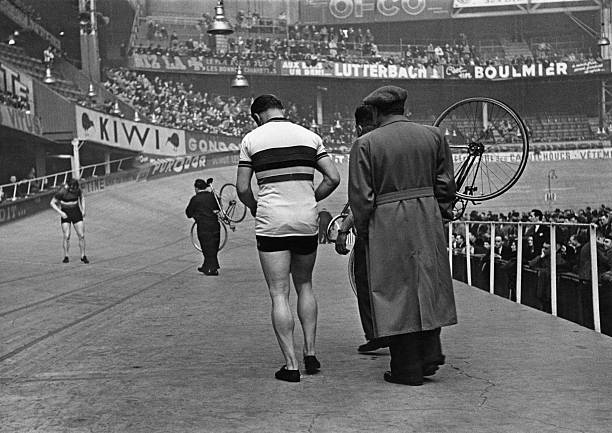
It’s hard to believe that we’ve been back in Aotearoa New Zealand for nearly eight months now. Goes fast. But while it seems like a lifetime ago my phone and Facebook feed prompt me with those “three years ago today” posts that remind us that yes, we really did spend four-and-a-half years living in France. One of those reminders was a couple of photos that I’d taken with the intention of writing a blog post, which I’d intended as another of those part travelogue, part history lesson posts that I really enjoyed writing while we were there. But I’d found this one really tricky to write, because it intersected with one of the darkest times in France’s history, the holocaust, and France’s efforts to come to terms with those.
The Winter Velodrome (the Velodrome d’Hiver, or Vel’ d’Hiv for short) was an important sporting and entertainment venue in Paris for most of the first half of the 20th Century. It hosted events from boxing, ice skate, six-day bike racing (of course), and even simulated lion hunting involving a pride of actual lions and a camel train with actual camels that were subsequently abandoned in a local park when the show turned to custard. True story.
But its place in history was secured by its role in one of France’s wartime atrocities. The Vel’ d’Hiv was used as a holding pen for some 13,152 people – including 4115 children and their parents – who had been rounded up by French police and gendarmes on 16 and 17 July 1942 under the instruction of the occupying German authorities. This wikipedia page has more detail, and tells how the people were held in appalling conditions at the height of summer, basically without food and water, and no working toilets, before taken by train to Auschwitz for their ultimate execution by the Nazis. It’s impossible to imagine what that must have been like. The roundup accounted for more than a quarter of the 42,000 Jews sent from France to Auschwitz in 1942, of whom only 811 returned. With the exception of six adolescents, none of the 3,900 children detained at the Vel d’Hiv and then sent to Auschwitz survived. It’s an unbelievably horrible thing, and the role of the French police in delivering Jews to the Nazis is something that France has struggled to come to terms with.
There’s a small memorial garden on the site where there velodrome used to stand, and memorial plaques record the names of the people that were held there. To be honest, it feels a bit underwhelming and it’s hard to get a sense of quiet to give the history of that space its proper weight. I’d originally planned a ride from there out to the Shoah memorial at Drancy, on the outskirts of the city. It’s one of the places where Vel’ d’Hiv detainees where held before their terrible train journey east. But COVID restrictions meant that didn’t happen. It would make a worthwhile ride.
Only one photo of the of the Vel’ d’Hiv roundup has been found, and it shows people being loaded onto buses to start their journey to Auschwitz:

If you know Paris well, you’ll recognise the back end of the Bir Hakeim metro station in the background. While we were living there I heard an urban myth that the site of the velodrome was gifted to the Australian government after the velodrome was demolised in the late 1950s, partly because no-one else wanted to buy the site given its role in the Shoah attrocities. But that’s not true, as the velodrome was on the other side of the metro tracks, and the memorial clearly marks where it once stood.
Of course, the Vel d’Hiv has strong links to cycling history, and to the Tour de France. The original venue attracted the attention of Henri Desrange, in 1902. One year later Desrange created the Tour de France. The original Vel’ d’Hiv was owned by owned by Victor Goddet who, with Desrange was co-founder and finance director of L.Auto, the newspaper that organised the first Tour in 1903. By 1942 ownership had passed to Victor Goddet’s son, Jacques, who ran the Tour for the half-century from 1936 to 1986. Goddet is probably the most important and influential person in 20th Century cycling history.
To be in the velodrome during one of the great six-day races must have been an astonishing and wonderful thing. Three tiers of spectators, with capacity for something like 25,000 spectators. I found watching the great Ghent 6-day, with probably a fifth the number of spectators a life-affirming experience. So as we remember the dark and troubling events of that the Vel’ d’Hiv is most known for, it’s important to remember that it was a also a place of great joy and sporting excitement. Those things don’t cancel each other out, and we should keep both in our memory as a reminder that just as people can do wonderful and astonishing things, we also have the capacity for the base and inhumane.
The velodrome featured in a wonderful photo essay by the great Henri Cartier-Bresson. You used to be able to see all of them on the Magnum photography website, but they’ve recently restricted access to pros only, but a quick Google image search reveals a few out there. They’re a wonderful celebration of cycling, and I was keen to get a copy for myself. But I couldn’t quite bring myself, knowing that the glamour and sporting celebration was thin veneer over the Vel’ d’Hiv’s dark history.




FRANCE. Paris. 1957. VÈlodrome d’Hiver. Six-day races. 
FRANCE. Paris. 1957. VÈlodrome d’Hiver. Six-day races.